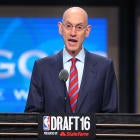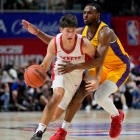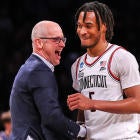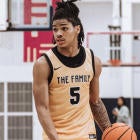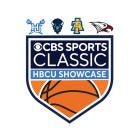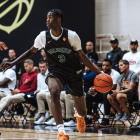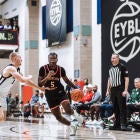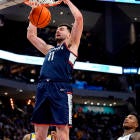NBA commissioner Adam Silver is publicly entertaining the idea of supporting a change to his league's controversial age-minimum draft rule. Since 2006, the NBA's collective bargaining agreement has put college basketball into a higher-profile but morally disputable one-and-done era, meaning prospects can only enter the NBA Draft only after they are 19 years old or a full calendar year removed from high school graduation.
On Wednesday, Silver went on "The Herd with Colin Cowherd" and admitted that the NBA's age-minimum rule is up for reconsideration.
"It may surprise you," Silver told Cowherd. "I'm rethinking our position."
The NBA has been steadfast, from the winter of David Stern's term as commissioner and seamlessly into Silver's reign, in refusing to allow high school prospects to be draft eligible. For decades, players were able to declare for the draft at 17, 18 years old. Most didn't, until Kevin Garnett altered the paradigm in 1995 until the league adopted its current rule in 2006. In recent years, Silver has said the league's desire was to raise the age minimum from 19 to 20.
"It's one that, I think, we need to be more thoughtful on -- not just be in an adversarial position, sort of under the bright lights of the collective bargaining," Silver said.
But some of Silver's reasoning appears flawed. In lamenting college basketball's unfixable problem (the best prospects will, most of the time, turn pro as soon as possible), Silver notes the Ben Simmons situation at LSU in 2015-16. As evidenced in a 2016 Showtime documentary, Simmons quit classes (after skipping plenty throughout the season) the day LSU's season ended.
But Simmons' bailout is not the norm. How do we know? The NCAA's Academic Progress Rate (APR) tracks players' classroom performance. Early NBA entrants flunking out of courses deteriorates a team's APR. The APR is far from perfect, but it forces programs to keep their grades and graduations rates high, lest they score too low and wind up with postseason bans.
"Even the so-called one-and-done players, I don't think it's fair to characterize them as going to one year of school," Silver said Wednesday. "What's happening now, even at the best schools, they enroll in those universities -- some great universities -- and they attend those universities until either they don't make the tournament, and the last game therefore of their freshman season, or to whenever they lose or win in the NCAA Tournament, that becomes their last day. So in essence it's a half-and-done, in a way."
This is a sweeping generalization. Kentucky, the poster program for the one-and-done era, has gone year after year after year with exceptional collective GPAs. If most one-and-done players were outright quitting school in March or early April, and not completing their freshman-year academic obligations, the APR would reflect that and we would see programs like Kentucky, Kansas, Duke, Arizona, UCLA and the like flirting with sanctions. But they are not.
So part of Silver's reasoning appears based in conjecture, though there is a separate and perhaps larger issue regarding the legitimacy of the classes, how they're being finished online in many cases as players go through NBA evaluations, and wondering if those players are truly doing all the work. Two things can be true at once: Silver can be overstating the culture of "half-and-done" while at the same time the APR does not accurately reflect what early entrants to the NBA Draft are (or aren't) doing to complete coursework in the back half of their spring semesters.
Silver also suggested that outgoing freshmen, on the whole, stay within their projected draft range from the time they finished their senior season of high school. He seems to argue: If that's the case, then what's the point of the stopover year in college?
"Selfishly, while I love college basketball and I'm a huge fan of college basketball, I worry about potential stunted development in the most important years in players' careers," Silver said. "Because the coaches in college don't have the same control they used to, because these guys know they're out of there. And it's amazing, there's very little movement. If you look at the draft projections for these players going into their first year in college, it holds fairly true. Maybe there's a little bit of movement, but these young men, they're followed so closely from the time they're 13 or 14 on."
While that's true, part of the impetus for the age minimum was to have older, more experienced, more mature players in the league. Just because a player is projected to be a top-five pick when he's 16 years old, then indeed winds up being a top-five pick when he's 19 years old doesn't mean the system is broken. After a year in college, it stands to reason that the player might be more adjusted and prepared to play in the NBA following 30-40 games at the Division I level rather than vaulting straight from high school. Until Silver spoke out against this on Wednesday, I thought this was a philosophical pillar he depended on.
If you're most interested in the rights of the player, the NBA should return to allowing high school-age kids to declare and let nature take its course. The league has the right to look out for its best business interests, though, and ultimately Silver -- even if he loves college basketball -- owes that sport nothing. The irony is the symbiotic relationship between the NBA and NCAA because of this ever-debated rule. If the NBA is most interested in having a stronger, older rookie class, the byproduct of that is uplifting college basketball's national viability and profile by inducing the best 17- and 18-year-olds to make the one-year rental agreement with college basketball.
College hoops has been a lot of fun over the past decade-plus with Greg Oden, Kevin Durant, John Wall, Derrick Rose, Lonzo Ball, Anthony Davis, Andrew Wiggins, Aaron Gordon, D'Angelo Russell, Josh Jackson, Jamal Murray, Jahlil Okafor and the list could go another 30 deep. One-and-done star power at top-10 programs has tangible in-season impact of the sport's coverage and enthusiasm that surrounds it.
Keeping the age minimum benefits both the league and the NCAA. Extending the age minimum to 20 can't be the answer, though. If anything, you'll have more players opting for the international route in an effort to make money. The twist here could be the NBA's reinforcements to the D-League. If the NBA can get enough money incentives there, might there be a scenario in which players could declare for the NBA coming out of high school, be mandated (a la the minor league system in MLB) to first start in the D-League before getting a call-up (say, post All-Star Break at the earliest?)
I find it very interesting that Silver is openly discussing this now. If he's willing to go public with this, it's reasonable to expect the NBA to have heavy discussions on this in the coming year or two. Major change could be coming to the NBA and college basketball, again, but before the NBA makes sweeping change the powers-that-be need to ask themselves if the league has been bettered over the past decade-plus by the institution of this rule.
The obvious answer is yes.








